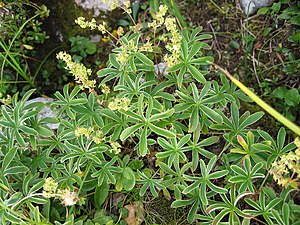Alchemilla sect. Glaciales
| Alchemilla sect. Glaciales | ||||||||||||
|---|---|---|---|---|---|---|---|---|---|---|---|---|

Ennstal silver mantle ( Alchemilla anisiaca ) |
||||||||||||
| Systematics | ||||||||||||
|
||||||||||||
| Scientific name | ||||||||||||
| Alchemilla sect. Glaciales | ||||||||||||
| SEFröhner |
Alchemilla sect. Glaciales is one of the 13 European sections of the genus Lady 's mantle ( Alchemilla ). Most of the species were earlier in the species group Alchemilla vulgaris agg. guided. The Glaciales sectionis a two-tier section: its species emerged from hybridization between the Alpinae and Pentaphylleae sections.
features
The plants look like coarse-toothed, less silky representatives of the Alpinae or like silky Pentaphylleae .
They are small to medium-sized dwarf shrubs . The seedlings have short internodes that are only up to one millimeter long . The adult plants have a major axis two to four millimeters thick that is long-lived. Often remains Mark for a long time, remains a long white and is not chambered. The bark parenchyma of the stem axis is often strongly developed. The first summer stems are often transformed into long-limbed, stem-like renewal shoots.
The primary leaf has three sections, which are often deeply incised and spreading. The basal leaves are reminiscent of the Alpinae section in most species , they are intermediate in some and only a few are similar to the Pentaphylleae section . However, they are always coarser than in Alpinae and have fewer nerves. The vascular bundles of the petioles are often collateral. The stipules are narrower than in the Alpinae section . They are often pointed, stay fresh for a long time, and are plump. The color is usually white or with a green tip. Their auricles are less fused, they have more parallel veins , and their tute cut is deeper than that of Alpinae .
The stems are prostrate to ascending. The stem leaves are often large, sometimes the same size as the basal leaves. At the lowest stem leaf, the stipules are often inflated and spreadless and spreading laterally. On the uppermost stem leaf, the stipules are cut to different depths and have one to eight tips. Sometimes renewal shoots are formed from the leaf axil under the first inflorescence branch.
The inflorescence usually has few to very few flowers. The partial inflorescences are mostly flaky and rarely have bracts . The flower stalk is usually long, at least never less than a millimeter. The flowers are greenish, not red. The terminal flower is often five-fold and has two carpels . In most cases, the goblet has thick, silky hairs; it is rarely almost bald. In some species it is brownish red. The sepals are often twice as long as they are wide. Their shape is often rounded or blunt to obovate. The base of the stamens is usually widened. The nuts are mostly hairless.
The chromosomes are sometimes somewhat elongated, some species have chromosomes with a constricted center.
The rhythm of life resembles that of the Alpinae section .
Distribution and locations
The species of the section occur in the high mountains in southern Europe and in the Middle East: Iberian Peninsula , Pyrenees , Alps , Apennines , Dalmatian Mountains, Turkey , Caucasus and possibly in Northern Iran.
The plants grow in crevices in the rock, on dormant rubble, in alpine mats, on snow soils. They mostly occur in higher altitudes than the species of the Alpinae section and are often found on limestone-rich soils.
Systematics
The Alpinae section is one of the four basic sections of the European Alchemilles, from which the remaining sections have emerged through hybridization.
The assignment of the species to the section follows Fröhner (1995), with changes to the section assignment and new species from Fischer (2008) being adopted. The Central European species are:
- Lady's mantle ( Alchemilla amphibola )
- Ennstal silver mantle ( Alchemilla anisiaca )
- Basalt lady's mantle ( Alchemilla basaltica )
- Wedge-leaf lady's mantle ( Alchemilla cuneata )
- Gemmi lady 's mantle ( Alchemilla gemmi )
- Ice silver coat ( Alchemilla glacialis )
- Coarse-toothed lady 's mantle ( Alchemilla grossidens )
- Bergjoch lady 's mantle ( Alchemilla jugensis )
- Shiny silk coat ( Alchemilla nitida )
- Matt glossy lady's mantle ( Alchemilla opaca )
- Pale lady's mantle ( Alchemilla pallens )
- Arm-leaved lady's mantle ( Alchemilla pentaphylloides )
- Lady's mantle ( Alchemilla petiolulans )
- Savoy lady 's mantle ( Alchemilla sabauda )
- Matte silver mantle ( Alchemilla subsericea )
- Vaccaris lady's mantle ( Alchemilla vaccariana )
supporting documents
Unless specified under individual evidence, the article is based on the following documents:
- Sigurd Fröhner: Alchemilla . In: Hans. J. Conert et al. a. (Ed.): Gustav Hegi. Illustrated flora of Central Europe. Volume 4 Part 2B: Spermatophyta: Angiospermae: Dicotyledones 2 (3). Rosaceae 2 . Blackwell 1995, pp. 198f. ISBN 3-8263-2533-8
Individual evidence
- ^ A b Manfred A. Fischer , Karl Oswald, Wolfgang Adler: Excursion flora for Austria, Liechtenstein and South Tyrol. 3rd, improved edition. State of Upper Austria, Biology Center of the Upper Austrian State Museums, Linz 2008, ISBN 978-3-85474-187-9 , p. 489.